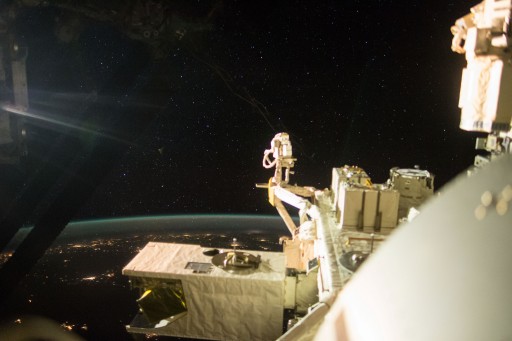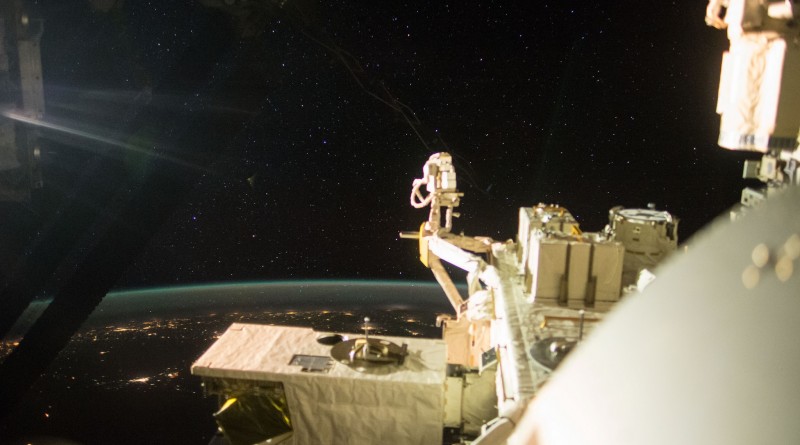ISS Operations Update – November 19, 2015

Experiments:
VEG-01 Wick Opening [VEGGIE or Veg-01 is a deployable plant growth unit to be set up on the Space Station to demonstrate the feasibility of a space garden. The experiment facility provides lighting and nutrient supply and is capable of supporting a variety of plant species that can be cultivated for educational outreach, fresh food and even recreation for crewmembers on long-duration missions. Thermal control is provided from ISS in-cabin systems and the carbon dioxide source is the ambient air aboard ISS.]
ESA Haptics [The Haptics-1 hardware flying to the International Space Station includes a single degree of freedom high-resolution force control joystick to be used in physiology research in zero-G with a technical element as this setup can find application in future space-telerobotics technology. The experiment will study how remote-controlled robot operation from space (telerobotics) can be accomplished with special focus on providing a haptic feedback to the controller in the form of force on the control device. This requires detailed knowledge on the effects of microgravity on force perception and motor control capability which has not been studied before. The experiment hardware consists of a joystick that uses a highly power-dense brushless direct-current actuator, an EtherCAT motor controller, custom-built force and torque sensors and flight computer using Commercial off-the-shelf components. The Haptics-1 joystick is mounted via standard space station interfaces to a body harness.]
Cognition [Cognition, also known as Individualized Real-Time Neurocognitive Assessment Toolkit for Space Flight Fatigue uses a battery of tests to measure how spaceflight-related physical changes (microgravity, lack of sleep quality, diet) can affect the cognitive performance of humans during long-duration space flights. The experiment consists of ten brief computer-based tests that cover a range of cognitive functions and deliver immediate feedback on current and past results. A good neurocognitive function for effective performance during space missions makes an investigation of sleep and fatigue in space an absolute necessity. The testing operation consists of a sleep questionnaire and subjective evaluations at the beginning followed by the ten tests that focus on: sensor-motor ability, visual object learning and memory, attention and working memory, abstraction, spatial orientation, emotion recognition, abstract reasoning, complex scanning & visual tracking, risk decision making, and vigilant attention and psychomotor speed.]
Biochemical Profiles [The Biochemical Profiles study obtains blood and urine samples from long-duration space travelers before, during and after space flight to monitor specific proteins and chemicals that act as biomarkers and allow an assessment of particular biological, biochemical, biophysical processes that affect the health of a human. Conducting frequent sampling allows for the generation of a database of samples and test results which allows scientists to study the effects of spaceflight on the physiology of humans and it also allows an assessment of countermeasures associated with exercise and nutrition. The experiment consists of eight in-flight sessions comprised of a fasting blood draw and 24-hour urine collection. Body mass measurements on a monthly basis are also evaluated as part of the study.]
Sleep ISS-12 [The ISS-12 experiment monitors the ambient light exposure and crew member activity and collects data on the subjective evaluation of sleep and alertness. Ambient light and activity are monitored via a wrist-worn actiwatch that delivers actiwatch spectrums that are put through bio-mathematical models of sleep and light to predict circadian phase. Sleep logs will be kept by crew members as a subjective assessment of sleep quality and duration. It is hoped that this investigation can deliver requirements for lighting, sleep-shifting protocols and workloads for future space exploration missions.]
Relaksatsiya Experiment Ops [Relaxation is an Earth Observation Experiment that uses the Photospectral Hardware to acquire spectral and photographic imagery of Earth’s surface and atmosphere under ground commanding.]
Saliva & Urine Sampling for Twins Study
Calcium Study [This experiment looks at the causes of the loss of bone density in humans undergoing long duration space missions. It uses calcium phosphate and human bone samples to assess the solubility of calcium and bone in water in a zero-G environment.]
Maintenance/Systems:
Nominal Inspections/Servicing Tasks (Morning Inspection, Caution & Warning Panel Check, Sozh System Maintenance) (Russian Crew)
EXPRESS (EXpedite the PRocessing of Experiments to Space Station) Rack 1 Laptop Software Load
Common Communications for Visiting Vehicle (C2V2) Cable Routing in Lab
Waste and Hygiene Compartment (WHC) Urine Receptacle (UR) Routine Maintenance
Changeout of Elektron Purification Column Assembly
Other Activities:
Story Time – Educational Event
PAO Event
Progress M-28M Cargo Operations

